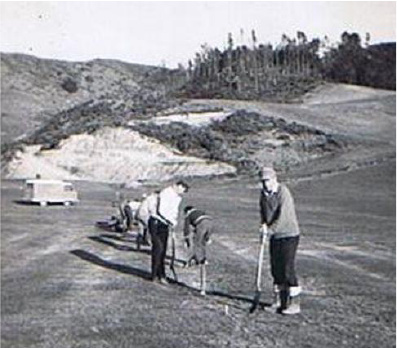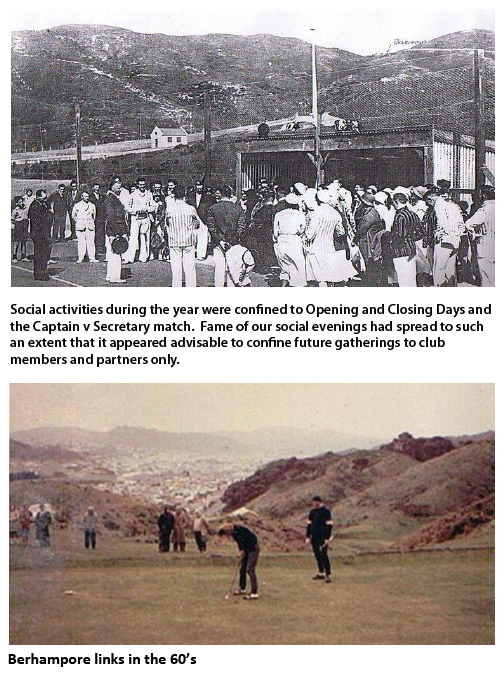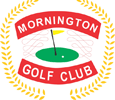
THE MORNINGTON GOLF CLUB 1916-1991
Proposed Berhampore Municipal Golf Links
In early 1914, a deputation headed by Dr R.A. Cameron and Mr A. Whitelaw went to the Wellington City Council with a scheme to create a nine hole golf course. The proposal was favourably received by Council and a Council Golf Committee was formed to look at plans, course formation, costs and upkeep of the proposed Municipal Golf Course.
An estimate of about £300 (300 pounds) to cover all expenses for gorse clearing, forming putting greens and tees and getting the course in good order for play, was tabled. It was suggested that once the course was formed into good playing condition, one man should be able to do all that was required to keep, the course in order and collect green fees etc. — the salary to be £3 per week.
W.C.C. Reserves Sub-Committee Meeting — 27 May 1914
Present: Crs Luckie (Chairman), Buddle and McKenzie, The City Engineer, Messrs J. Watt (Heretaunga Golf Professional), G.A. Sutton and W. Simpson. The Mayor sent an apology for non-attendance, but intimated that he would be only too pleased to do what he could to further the proposal on the agenda.
Mr Sutton reported that the membership lists in other clubs were all full and many applicants were waiting for admission. He said that with a fairly good playable nine hole course, his estimates of the receipts would be at least £300 per annum. Listed membership of the clubs around Wellington were as follows: Miramar 400, Heretaunga 407, Karori 200, Hutt 250, Johnsonville 150, Waiwhetu 100. Total 1507.
It was arranged that the City Engineer, with Messrs Watt and Simpson, would have the course pegged and surveyed. The measurements would be shown on the subsequent plan and supplied to the Reserves Sub-Committee within about three weeks.
On 30 March 1915, four professional golfers surveyed the course and on 30 October of that year the 9 holes, bogey (par) 39, Wellington Municipal Golf Links (later to be renamed Berhampore Municipal Golf Links) was opened for play by the professionals Messrs Watt, Duncan, Marshbank and Douglas.
Inauguration of the Mornington Golf Club
On 29 January 1916, 18 men attended the first meeting in a pavilion of the Wellington Municipal Golf Links, Berhampore.
Present: Dr R.A. Cameron (Chairman), Messrs P.W. Bass, A.J. Cameron, N.F. Dunlop, T. Howse, T. Gibson, T. Johnson, G. McCarthy, J.M. McIntosh, L.J. Pirani, R. Richmond, A. Rogers, G.H. Scott, J.P. Shand, S.R. Shannow, J.T. Twomey, P.C. Watt and W. Whitehead. It was resolved that those present form themselves into a club to be called The Wellington Municipal Golf Club.
The First Elected Executive and Committee
Chairman-Captain Dr R.A. Cameron
Secretary Mr W. Whitehead
Treasurer Mr J.M. Mcintosh
Committee Men: Messrs N.F. Dunlop, T. Gibson, A. Rogers, G.H. Scott and P.C. Watt.
On 24 June 1916 the following team was chosen to play against the Waiwhetu Golf Club: W. Whitehead, L.B. Rhodes, J.T. Bowness, F.N. Dunlop, A. Rogers and J. McIntosh. (Note: This was the first recorded team). it was in this year of the club’s history that a clubhouse consisting of a two roomed building was secured for men and lady golfers, on a level part of the town belt where Britomart and Farnham Streets meet in the suburb of Mornington. The building was leased from the Wellington City Council. Dr Cameron (Club Chairman-Captain) who was a City Councilor in 1913 and 1914 was highly regarded by the Council. It had been said that the lease was ‘pushed through’ at the request of the good doctor.

3rd Annual General Meeting — 8 March 1919 At this meeting, a proposal was put to the members that the name of the club be changed to either ‘The Berhampore Golf Club’ or ‘The Mornington Golf Club’, and a ballot of members be taken to determine the name they prefer. The voting was in favour of ‘The Mornington Golf Club’. Club Days of Competition Change From Saturday to Sunday In the early 1920’s, the club hired a King’s Counsel to persuade a reluctant City Council to permit change from Saturday play to Sunday play. The change resulted in a marked increase in membership and increased activity on the links.

Local Rule:
It was decided that a temporary local rule be made, allowing a ball lifted and dropped without penalty from hoof marks on the 10th fairway
26 April 1937
25 March 1925
The second nine holes on the eastern side were completed about this time. Mr T.A. (Tim) Johnston (a first year member) recounted how members had to cut neck high gorse to make way for the new holes, and fence the greens to keep horses and cows off.With the completion of 18 holes, Wellington’s Municipal golf links had come of age, with breathtaking views when the summit at the 11th tee between Mt Albert and Houghton Bay Road was reached. Affectionately named The Goat Track’, the course was reputed by many to be the most loved and most hated in New Zealand. A golfer could hit a ball off one of its blind tees and never see it again. You needed the hardiness of a mountaineer to negotiate its steep and rugged hills, and balancing skills to withstand the wind that swept in from the sea. Some of the greens were poor, very poor. Artificial watering was unheard of and the paths over which golfers pulled their trollies, in many places were little better than miniature river beds, uneven and rocky. Ever encroaching gorse had to be constantly kept under control, usually by voluntary club working parties. Heavily overgrown water courses and high rough added to the difficulties facing golfers who were not consistently accurate. But, in spite of all that, club members were out at first light of day for a round of golf, be it championship finals or just a stableford competition. These people had no special rights on the course ahead of the general public.
The Question of Cheaper Beer
The Treasurer reported that $5,917.50 had been spent in purchasing 7,045 flagons at 84c per flagon at the Southern Cross Hotel during the 1972-73 season. He said Mr Coltman of the Grand Hotel had offered beer at 70c per flagon. The Treasurer asked the club to accept this new offer and save $1,000 per year. Mr Coltman’s offer was accepted together with his offer to donate a trophy (Coltman Cup) for our Veteran’s Tournament.
The question of lowering the price of beer to the members was considered. It was resolved, however, that the price would remain at $1.00 per flagon.
Typical Sunday Competitions & Club Procedure During the 1940s 7am start. Soup after 9 holes. Stew or silverside corned beef was the standing menu for lunch. Club members were given a feed so that they would stay on and buy bottled beer which was stored in lockers.
Many Mornington golfers can be classed as a race apart, in the sense that they prepared for a round of golf at Mornington differently from other courses. For a start, golf trundlers were ‘out’. It was no fun dragging one of those over the tortuous slopes. It was a case of travelling light. A small bag with a few clubs was usually the order of the day. One ingenious fellow was seen to have made his own bag by sewing up the leg of a trouser. Some members did not bother to carry a bag at all. They just carried a few clubs by hand. The footwear too was interesting. Hob nailed boots or gumboots were often worn.

LIFE MEMBERS
1931 J.T. Bowness
1931 T.A. Johnston
1931 A. Rawlings
1932 D. Hartwell
1934 E. Cooper
1934 H.J. Shanks
1941 N. Sandford
1942 J.D. Sievwright
1944 D.B. Stratmore
1945 L.J. Evans
1948 J. Watkins
1950 A.E. Watkins
1953 A.A. McLean
1954 D. Emmerson
1960 E.C. Wheeler
1963 V.A. Fordham
1966 K.M. Baker
1967 J.B. Lawson
1969 S.D. Jacobi
1972 R.L. Mason
1975 K. Olivant
1976 R.J. Watts
1980 J.P.G. Bartley
1981 M.W. Lousich
1982 P. Roovers
1983 L. Clark
1985 J.G. Fagan
1985 R.J. Condon
1987 J.S. Myers
1988 D.D. MacKenzie
1989 A.P.W. Church
1989 V.H Blair
1989 C Boyce


